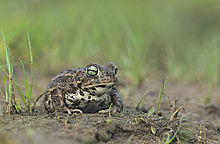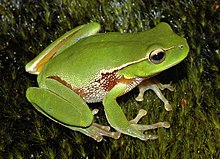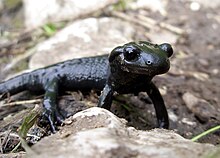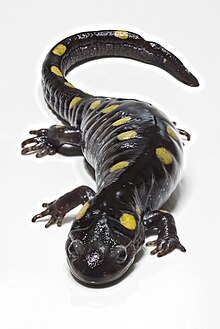Portal:Amphibians
The Amphibian Portal
Amphibians are ectothermic, anamniotic, four-limbed vertebrate animals that constitute the class Amphibia. In its broadest sense, it is a paraphyletic group encompassing all tetrapods, excluding the amniotes (tetrapods with an amniotic membrane, such as modern reptiles, birds, and mammals). All extant (living) amphibians belong to the monophyletic subclass Lissamphibia, with three living orders: Anura (frogs), Urodela (salamanders), and Gymnophiona (caecilians). Evolved to be mostly semiaquatic, amphibians have adapted to inhabit a wide variety of habitats, with most species living in freshwater, wetland or terrestrial ecosystems (such as riparian woodland, fossorial and even arboreal habitats). Their life cycle typically starts out as aquatic larvae with gills known as tadpoles, but some species have developed behavioural adaptations to bypass this.
The young generally undergo metamorphosis from larva with gills to an adult air-breathing form with lungs. Amphibians use their skin as a secondary respiratory surface and some small terrestrial salamanders and frogs lack lungs and rely entirely on their skin. They are superficially similar to reptiles like lizards, but unlike reptiles and other amniotes, require water bodies in which to breed. With their complex reproductive needs and permeable skins, amphibians are often ecological indicators; in recent decades there has been a dramatic decline in amphibian populations for many species around the globe.
The earliest amphibians evolved in the Devonian period from sarcopterygian fish with lungs and bony-limbed fins, features that were helpful in adapting to dry land. They diversified and became ecologically dominant during the Carboniferous and Permian periods, but were later displaced in terrestrial environments by early reptiles and basal synapsids (mammal predecessors). The origin of modern amphibians belonging to Lissamphibia, which first appeared during the Early Triassic, around 250 million years ago, has long been contentious. The most popular hypothesis is that they likely originated from temnospondyls, the most diverse group of prehistoric amphibians, during the Permian period. Another hypothesis is that they emerged from lepospondys. (Full article...)
Selected frog article
The Pelobatoidea are a superfamily of frogs. They typically combine a toad-like body shape with a frog-like, pointed face (hence the German name 'Krötenfrösche', literally 'toad frogs'). Phylogenetically they stand between primitive frogs (fire-bellied toads, midwife toads) on the one side and higher frogs (the family of true toads, tree frogs, and the family of true frogs) on the other and are therefore – among other things by characteristics of bone construction – in the suborder Mesobatrachia.
Per 2016, the Pelobatoidea contain 202 species in 11 genera and 2 families. The distribution covers Europe, North Africa and West Asia (Family Pelobatidae) and Southeast Asia (family Megophryidae). Their sister group are the Pelodytoidea, consisting of North American spadefood toads and parsley frogs.
A striking characteristic is the vertically slit pupil in daylight. The tongue is thick, circular, and almost entirely adhering to the floor of the mouth. When mating the males clutches the females in the lumbar region, just before the hind legs (inguinal Amplexus). (Full article...)Selected salamander article
The Salamandroidea are a suborder of salamanders, referred to as advanced salamanders. The members of the suborder are found worldwide except for Antarctica, sub-Saharan Africa, and Oceania. They differ from suborder Cryptobranchoidea as the angular and prearticular bones in their lower jaws are fused, their trunk ribs are bicapitate, and all members use internal fertilization. The female is fertilized by means of a spermatophore, a sperm-containing cap placed by the male in her cloaca. The sperm is stored in spermathecae on the roof of the cloaca until it is needed at the time of oviposition.
The earliest known salamandroid fossils remain contested. Some studies suggest that the earliest salamandroids are represented by specimens of the species Beiyanerpeton jianpingensis and Qinglongtriton gangouensis from the Tiaojishan Formation of Inner Mongolia, China, dated to the Late Jurassic about 157 million years ago. Alternative analyses suggest that Beiyanerpeton jianpingensis and Qinglongtriton gangouensis are stem salamanders and that the oldest known certain salamandroid is Valdotriton gracilis from the Early Cretaceous of Spain, about 127 Ma. (Full article...)List of selected salamander articles
|
|---|
Did you know? –

- ...that the extinct crocodile-like Prionosuchus (scale image pictured) is the largest amphibian known to have existed?
- ... that the Iberian frog includes beetles, caddisflies and spiders in its diet?
- ...that the California slender salamander (pictured) has a physique to invade narrow tunnels of earthworms for predation and cover?
- ... that Wilmer W. Tanner wrote his Ph.D. thesis on the comparative anatomy of salamanders from Mexico and Central America?
- ... that the new genus of frog Mercurana was named after the late British rock singer Freddie Mercury?
Selected amphibian type
Salamanders are a group of amphibians typically characterized by their lizard-like appearance, with slender bodies, blunt snouts, short limbs projecting at right angles to the body, and the presence of a tail in both larvae and adults.
All ten extant salamander families are grouped together under the order Urodela from the group Caudata. Urodela is a scientific Latin term based on the Ancient Greek οὐρά δήλη: ourà dēlē "conspicuous tail". Caudata is the Latin for "tailed ones", from cauda : "tail".
Salamander diversity is highest in eastern North America, especially in the Appalachian Mountains; most species are found in the Holarctic realm, with some species present in the Neotropical realm. (Full article...)Selected images
Selected toad article

The natterjack toad (Epidalea calamita) is a toad native to sandy and heathland areas of Europe. Adults are 60–70 mm (2.4–2.8 in) in length, and are distinguished from common toads by a yellow line down the middle of the back and parallel paratoid glands. They have relatively short legs, which gives them a distinctive gait, contrasting with the hopping movement of many other toad species.
Natterjacks have a very loud and distinctive mating call amplified by the single vocal sac found under the chin of the male. (Full article...)Selected caecilian article
Luetkenotyphlus is a genus of caecilians in the family Siphonopidae.
Species recognized (as of October 2019):
- Luetkenotyphlus brasiliensis (Lütken, 1851)
- Luetkenotyphlus fredi Maciel, Castro, Sturaro, Silva, Ferreira, Santos, Risse-Quaioto, Barboza, Oliveira, Sampaio, and Schneider, 2019
- Luetkenotyphlus insulanus (Ihering, 1911)
Need help?
Do you have a question about Amphibians that you can't find the answer to?
Consider asking it at the Wikipedia reference desk.
Topics
Subcategories
Related portals
Associated Wikimedia
The following Wikimedia Foundation sister projects provide more on this subject:
-
Commons
Free media repository -
Wikibooks
Free textbooks and manuals -
Wikidata
Free knowledge base -
Wikinews
Free-content news -
Wikiquote
Collection of quotations -
Wikisource
Free-content library -
Wikiversity
Free learning tools -
Wiktionary
Dictionary and thesaurus










































